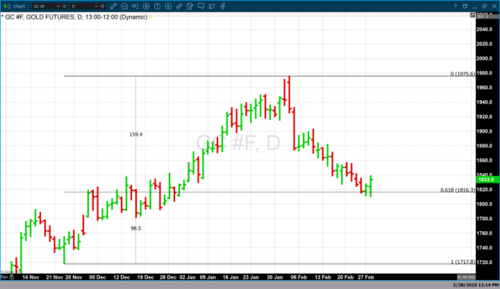
Gold trades higher for a second consecutive day overcoming dollar strength
After four consecutive days in gold traded to a lower high, a lower low, and a lower close than the previous day, traders have witnessed a pivot that began yesterday. Gold futures traded to the lowest value today hitting an intraday low of $1810.80. This follows yesterday’s prior lowest low of $1812. However, both yesterday and today gold closed higher when compared to the previous day and higher when compared to its opening price.

While today’s green candle with a higher high does not on its own confirm a conclusion to the correction that began in the middle of January when gold prices hit their highest value ($1974) of the calendar year, this is how a reversal would look if gold continues to move higher in the upcoming days. In yesterday’s video report, we talked about the importance of $1815 as a key price point to look at for potential support.
This was based on a Fibonacci retracement of 61.8% which is a deep but acceptable correction. The data set used for the Fibonacci retracement covers the entire price area from the most recent leg of the rally. This rally begins at $1719 the low that completed a mild correction during the third week of November, to this year’s high at $1974 (the conclusion of the last rally). What followed was a quick and brutal correction from $1974 down to today’s low at $1810.80.
As of 5:00 PM EST gold futures basis the most active April contract is currently up $8.90 or 0.49% and fixed at $1833.80. Today’s gains in gold overcame dollar strength. The dollar is currently up 0.32 points or 0.31% with the dollar index fixed at 104.945.
It does appear as though the month will conclude with two moderate days of gains. That being said, gold’s performance during February 2023 was atrocious. Gold’s value declined by approximately 5% and will go in the record books as the worst monthly decline since June 2021. This month’s decline was largely based on the conviction that the Federal Reserve will continue its extremely hawkish monetary policy including more interest rate hikes and keeping those elevated levels for a longer time.
The latest kink in the Federal Reserve’s armor was that the most recent inflation reports came in unexpectedly higher rather than showing a continued decline in inflationary pressure. When compared to the previous month, the core PCE rose by 0.6% in January, bringing the year-over-year PCE to 5.382%.
The Federal Reserve will hold its next FOMC meeting on March 22-23. Before that meeting, there will be critical reports that will help shape the next rate hike Implemented by the Federal Reserve.
On March 10 the US Labor Department will release its latest jobs report for February. Then on March 14, the government will release the CPI inflation index for January. Collectively, these two reports will be the most current data used by the Federal Reserve to determine the amount of the next rate hike.
According to the CME’s FedWatch, there is a 73.8% probability that the Fed will raise rates by 25 BPS and a 26.2% that the Fed will be more aggressive with a 50 BPS rate hike.
By Gary Wagner
Contributing to kitco.com
Tim Moseley
